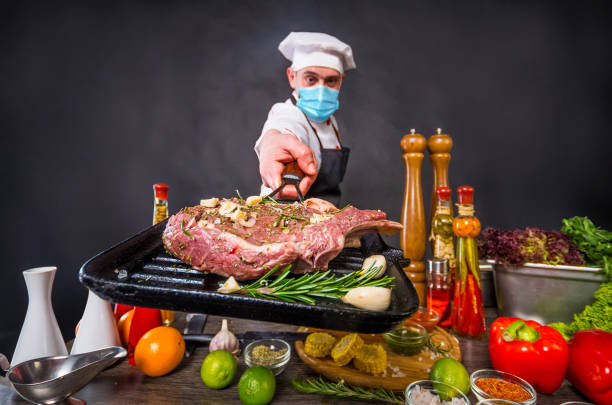Steakhouses have long been a symbol of luxurious dining and a classic night out. However, as times change and dining trends evolve, some steakhouses that once dominated the culinary scene have faded into obscurity. Below is a list of some forgotten steakhouses that have either closed their doors or seem to be headed in that direction:
Steak and Ale
In the 1960s, when steak dinners were considered a rare and expensive indulgence, Steak and Ale burst onto the scene in Dallas. It brought the steakhouse experience to the suburbs at affordable prices. This chain introduced innovative ideas such as a lunch menu priced lower than dinner, free refills on soda, and an all-you-can-eat salad bar. With nearly 300 locations by the mid-1980s, Steak and Ale became a prominent fixture in the American dining landscape.
However, success came at a cost. The growing and competitive casual dining scene it helped create eventually led to its downfall. In 2008, Steak and Ale’s owners filed for bankruptcy, resulting in the immediate closure of all 58 locations. It was a sad end for a chain that had once revolutionized the steakhouse experience.
York Steak House
York Steak House had its heyday in the era of shopping malls. Starting with its first outlet in Columbus, Ohio, in 1966, York Steak House quickly expanded its presence by opening locations adjacent to competitors in malls across the country. With a variety of cuts of beef, potato options, and a trip to the salad bar, it catered to the growing suburban dining crowd.
However, the evolution of malls, which introduced cheaper fast-food options in food courts, proved to be a challenge for York. In the 1980s, the chain faced a decline and began closing restaurants as quickly as it had once opened them. Today, only one outlet remains, in its original hometown of Columbus, Ohio, serving as a reminder of a bygone era.
Beefsteak Charlie’s
The allure of all-you-can-eat dining was irresistible to many, and Beefsteak Charlie’s capitalized on that trend. This chain gained popularity in the mid-1970s by offering generous portions of ribs, chicken dishes, and steaks at competitive prices. Their all-you-can-eat salad bar, featuring endless shrimp, and unlimited refills on ice cream, soda, beer, wine, and sangria, made it a favorite among customers.
However, the business model had its challenges. Offering so much for free made it difficult to turn a profit. After a bankruptcy filing in 1989, Beefsteak Charlie’s disappeared from the culinary scene, leaving behind memories of indulgent feasts and the gregarious character of Beefsteak Charlie himself.
Victoria Station
In the mid-20th century, diners had plenty of steakhouse options, but Victoria Station stood out with its unique concept. Its dining rooms were constructed from old boxcars, creating a nostalgic, train-themed atmosphere. Graduates of the School of Hotel and Restaurant Administration at Cornell University founded the first Victoria Station in San Francisco in 1969. By the late 1970s, nearly 100 Victoria Stations were operating across North America.
However, the chain’s rapid expansion proved to be its downfall. Financial challenges arose from expanding too quickly, and by 1986, Victoria Station had to file for Chapter 11 reorganization. Most of its restaurants closed, leaving a solitary location in Salem, Massachusetts, which survived until 2017. Its closure was a blow to the community, particularly the Salem Children’s Charity, which had been hosting its annual Christmas party at the restaurant for over two decades.
Lone Star Steakhouse and Saloon
In the 1990s, family-oriented, mid-scale steakhouse chains like Texas Roadhouse and Outback Steakhouse dominated the market. Lone Star Steakhouse and Saloon was another major player in that realm. Founded in 1989 by Jamie B. Coulter, who used his profits as a franchisee of multiple Pizza Huts to launch the concept, Lone Star quickly grew to 265 locations across the United States by the end of the 1990s.
However, the novelty of the chain faded, and it struggled to compete. Economic crises, coupled with poor financial management, led to a decline in the number of locations. By 2023, only a single Lone Star Steakhouse remained open, located on the U.S. island territory of Guam. It serves as a reminder of a time when Lone Star was a major player in the steakhouse landscape.
Valle’s Steak House
Valle’s Steak House once thrived as a multi-location chain in New England. From its humble beginnings as a 12-seat restaurant in Portland, Maine, in 1933, it expanded rapidly, serving large steaks at affordable prices to a loyal customer base. The chain’s success led to the opening of multiple locations and employed thousands of people.
However, financial challenges plagued the Valle family. After the death of the chain’s founder in 1977, estate taxes took a toll on the business. As the 1980s progressed, Valle’s gradually closed down its restaurants, leaving only one in Portland, which operated until 2000. It was a bittersweet end for a chain that had once been a New England institution.
Here are more once popular steakhouses that are no longer around here:
